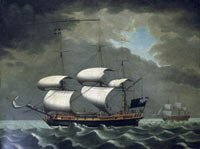|
The Transatlantic slave trade required the services of officers and crewmembers of various skills; these included cooks, carpenters for ship maintenance, coopers to make barrels, casks for fresh water and alcohol, blacksmiths, surgeons, etc.
Throughout the 400-year period of the transatlantic slave trade, life for most Europeans was harsh, and in crossing the Atlantic Ocean (and other long distance journeys resulting from the discovery of new areas of the world), sailing and the life of a sailor were particularly brutal.
|
 © National Maritime Museum © National Maritime Museum |
Sailing brought with it many dangers to life and health through natural disaster, attack from other ships through war and piracy, poor nutrition and sanitation. Sailors were often cruelly treated and their time at sea away from land and home often lasted for many months, for example a trip from the Caribbean to England might have lasted three months. The mortality rate for sailors on slave ships may have been as high as 20 per cent.
Although payment on a slave ship might have been considered good, there were too few people willing to become sailors out of personal desire. This was also true of sailing generally. Out of this need for labour a system known as press-ganging came into use. To press was to force (legally) someone into military service in the army or the navy and was not devised to satisfy the slave trade. Despite this, it was used to procure young men and boys into the service of slave ships and their captains.
Gangs of men, press-gangs, would capture and force suitable individuals into the service of these captains against their will. Often the methods used were deceiptful. For example, the coercion of young men into debt or getting them drunk and taking them away were often employed.
Once captured it was almost impossible to escape. Out at sea there was nowhere else to go, and shore leave was restricted. Also, there was the matter of getting paid to consider, and leaving a ship for a strange and hostile land would not have been appealing. However, there were sailors who did want to stay in the Caribbean while others were desperate to return home. This was often because a sailor could spend many months at sea in poor conditions before spending even a fleeting moment on dry land.
In terms of slaving, a few round-trips of the triangular trade were enough to condition individuals to the rigors of sea life and the horrors of slave trafficking, especially of the middle passage. It was also possible for a sailor to purchase a slave of his own and make a profit, providing he cared for the slave himself during the voyage. In time, therfore, sailing on a slave ship though treacherous was comparitively well paid and lucrative and many crewmembers aspired to promotion ultimately longing to become traders themselves as was often the case with slave ships’ captains.
|

